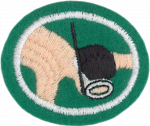Difference between revisions of "AY Honors/Skin Diving/Answer Key/es"
From Pathfinder Wiki
< AY Honors | Skin DivingAY Honors/Skin Diving/Answer Key/es
(Created page with "{{clear}}") |
(Created page with "{{clear}}") |
||
| Line 109: | Line 109: | ||
{{clear}} | {{clear}} | ||
| − | + | {{clear}} | |
* Learn belly-breathing (diaphragmatic breathing) techniques and practice them. People who hyperventilate typically take shallow breaths, filling only their upper chest when they inhale. | * Learn belly-breathing (diaphragmatic breathing) techniques and practice them. People who hyperventilate typically take shallow breaths, filling only their upper chest when they inhale. | ||
Revision as of 16:32, 8 February 2021
| Buceo | ||
|---|---|---|
| Asociación General
|
Destreza: 2 Año de introducción: 1961 |
|
Requisitos
|
La especialidad de Buceo es un componente de la Maestría Acuática. |
1
Tener la especialidad de Natación II.
Para consejos e instrucciones, véase Natación II.
2
Nombrar tres requisitos previos para una persona que desea participar en buceo con esnórkel.
3
¿Qué equipo es esencial para el buceo con esnórkel?
4
Conocer el efecto de los siguientes factores en el buceo con esnórkel:
4a
Tipos de playas
4b
Oleaje y corrientas
4c
La vida marina
5
¿Cuáles son las reglas del buen deporte en el buceo con esnórkel?
6
¿Qué precauciones de seguridad deben seguirse, mientras se hace el buceo con esnórkel?
7
Describir las técnicas aplicadas en comunicaciones, prevención de la hiperventilación y aclaramiento de la máscara.
- Learn belly-breathing (diaphragmatic breathing) techniques and practice them. People who hyperventilate typically take shallow breaths, filling only their upper chest when they inhale.
- Experiment with different relaxation techniques and see what works best for you.
- Talk to friends, family members, or a counselor to help you relieve anxiety. Keep a journal to help you focus on your problems and find workable solutions.
- Eat a nutritious diet. Reduce the caffeine in your diet by limiting your intake of caffeinated coffee, tea, soft drinks, and chocolate.
- Exercise. Regular aerobic exercise forces you to take full breaths and helps you to reduce anxiety that contributes to hyperventilation.
- Make sure you get good sleep at night. Being rested may help reduce daytime anxiety.
Hypothermia Treatment
- Dry the hypothermic person and cover him or her with blankets.
- Shelter the person from wind and water.
- Provide heat to the neck, underarms, and groin. Initially, heat only the trunk to avoid core temperature afterdrop. Afterdrop occurs when the extremities cool faster than the trunk. If the extremities are rewarmed, the colder blood within them will reenter the circulation and temporarily worsen the hypothermia.
- Keep the person lying down.
- Administer warm fluids only after the victim stops shivering (loss of the shivering reflex signifies significant hypothermia).
- Avoid suddenly moving/jarring the person because this may trigger an abnormal heart rhythm.
- CPR may be necessary. Resuscitation efforts should be continued until the person's body temperature rises to at least 95°F/35°C (never give up: one reported victim recovered in a morgue). All temperatures indicated are rectal measures, which give a closer indication of core temperature. If the person with hypothermia is cooperative, the temperature may be taken by mouth or other method.
8
Demostrar una prueba práctica en aguas de profundidad a la cintura y un buceo cualificado con esnórkel en aguas en mar abierto.
Here is where you get wet and have some fun.
References
Categories:
- Categoría: Tiene imagen de insignia
- Adventist Youth Honors Answer Book/Honors/es
- Adventist Youth Honors Answer Book/es
- Adventist Youth Honors Answer Book/Skill Level 2/es
- Categoría: Libro de respuestas de especialidades JA/Especialidades introducidas en 1961
- Adventist Youth Honors Answer Book/General Conference/es
- Adventist Youth Honors Answer Book/Recreation/es
- Adventist Youth Honors Answer Book/Recreation/Primary/es
- Adventist Youth Honors Answer Book/Stage 0/es
- Adventist Youth Honors Answer Book/Aquatic Master Award/es
- AY Honors/Prerequisite/Swimming - Intermediate/es
- AY Honors/See Also/Swimming - Intermediate/es
- Adventist Youth Honors Answer Book

